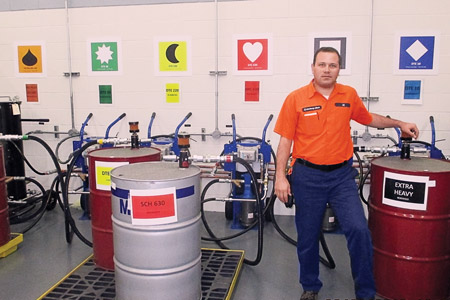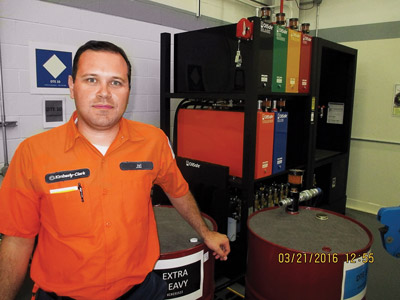Salem Manages World-class Lube Program for Kimberly-Clark
- Name
- Jad Salem
- Age
- 32
- Job Title
- Mechanical Project Engineer
- Company
- Kimberly-Clark Corp.
- Location
- Fullerton, California
- Length of Service
- 4 years
After working at a tissue-converting plant in Beirut, Lebanon, Jad Salem came to the United States and began his career at Kimberly-Clark’s tissue mill in Fullerton, California. He soon transitioned into his new role as a mechanical lead engineer on the rejuvenate and improve (R&I) team. As an R&I engineer working on capital projects, Salem received a request from the reliability team to build a centralized lubrication room for the mill and to improve the overall lubrication process from the time new oil enters the mill to the time it exits the facility. He is currently finishing the last part of this new lube room project, which will result in the organization of tools and materials into labeled and color-coded storage locations as well as kits that contain just what is needed to perform a task.
Q: What types of training have you taken to get to your current position?
A: I have taken a Kepner-Tregoe workshop and several online classes that have helped me better communicate and manage the team. To improve my technical skills, I have completed Noria’s machinery lubrication training, a bearing failure analysis course and a pump system design course. I am also certified in the Festo Pneumatic System. In addition, I have participated in several kaizen workshops at Kimberly-Clark.
 Q: Are you planning to obtain additional training or achieve higher certifications?
Q: Are you planning to obtain additional training or achieve higher certifications?
A: I am currently scheduled to attend the project management training offered by Kimberly-Clark. I will continue working and interacting with our well-skilled master technicians to sharpen my skills.
Q: What’s a normal work day like for you?
A: Normally my responsibilities are mixed between leading and/or supporting capital projects at different Kimberly-Clark mills. I also support the reliability team, focusing on managing a world-class lubrication program here at the mill.
Q: What is the amount and range of equipment that you help service through lubrication/oil analysis tasks?
A: We estimate having more than 3,750 pieces of equipment for oil analysis, ranging from oil tanks and pumps to high-viscosity gearboxes. We also have a variety of electric motors that we need to lubricate.
 Q: What have been some of the biggest project successes in which you’ve played a part?
Q: What have been some of the biggest project successes in which you’ve played a part?
A: I provided engineering support for the rebuild at the mill in Chester, Pennsylvania. This project reduced the safety risks associated with several operator tasks, increased machine reliability and stability, improved production quality, and eliminated injuries. I have also investigated and submitted several cause failure reports at the mill and led the implementation of countermeasures. I am currently supporting a steam optimization project, which will save the Fullerton mill $310,000 annually through reduced natural gas consumption, carbon-dioxide emissions and downtime associated with steam-related issues.
Be Featured in the Next ‘Get to Know’ Section
Would you like to be Features in the Next "Get to Know" section or know someone who should be profiled in an upcoming issue of Machinery Lubrication magazine?
Nominate yourself or fellow lubrication professionals by emailing a photo and contact information to editor@noria.com.
Q: How does your company view machinery lubrication in terms of importance and overall business strategy?
A: Kimberly-Clark’s Fullerton mill has come a long way in the past few years, and it didn’t happen by itself. Our maintenance team saw the importance of machinery lubrication, especially after they went through the training provided by Noria. The mill’s technicians are working continuously to sharpen their skills.
Q: What do you see as some of the more important trends taking place in the lubrication and oil analysis field?
A: I believe a good oil analysis program is key. Last year we were able to predict a bearing failure a week before it happened. Oil analysis showed metal shavings in the 900-gallon oil tank. This find allowed us to better plan for bearing replacement.
Q: What has made your company decide to put more emphasis on machinery lubrication?
A: Seeing improvement in overall machine operation has been the main drive behind the emphasis on machinery lubrication. These efforts resulted in a 0.06-percent water reduction in 2013 and a 35.6-gallon reduction in oil consumption between 2012 and 2013.
